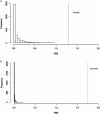Genetic signature of natural selection in first Americans
- PMID: 28193867
- PMCID: PMC5338486
- DOI: 10.1073/pnas.1620541114
Genetic signature of natural selection in first Americans
Abstract
When humans moved from Asia toward the Americas over 18,000 y ago and eventually peopled the New World they encountered a new environment with extreme climate conditions and distinct dietary resources. These environmental and dietary pressures may have led to instances of genetic adaptation with the potential to influence the phenotypic variation in extant Native American populations. An example of such an event is the evolution of the fatty acid desaturases (FADS) genes, which have been claimed to harbor signals of positive selection in Inuit populations due to adaptation to the cold Greenland Arctic climate and to a protein-rich diet. Because there was evidence of intercontinental variation in this genetic region, with indications of positive selection for its variants, we decided to compare the Inuit findings with other Native American data. Here, we use several lines of evidence to show that the signal of FADS-positive selection is not restricted to the Arctic but instead is broadly observed throughout the Americas. The shared signature of selection among populations living in such a diverse range of environments is likely due to a single and strong instance of local adaptation that took place in the common ancestral population before their entrance into the New World. These first Americans peopled the whole continent and spread this adaptive variant across a diverse set of environments.
Keywords: first Americans; genetics; natural selection; peopling of America.
Conflict of interest statement
The authors declare no conflict of interest.
Figures




References
-
- Hoffecker JF, Elias SA, O’Rourke DH. Anthropology. Out of Beringia? Science. 2014;343(6174):979–980. - PubMed
-
- Hopkins DM. The Bering Land Bridge. Stanford Univ Press; Stanford, CA: 1967.
Publication types
MeSH terms
Substances
LinkOut - more resources
Full Text Sources
Other Literature Sources

